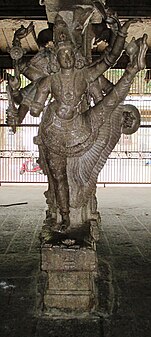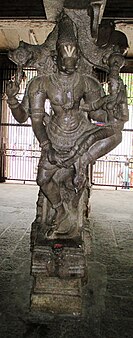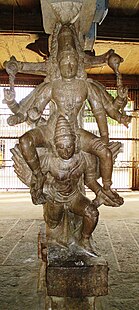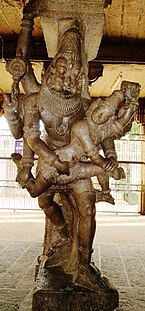Kallalagar Temple
| Kallalagar Temple | |
|---|---|
Kallalagar | |
 | |
| Religion | |
| Affiliation | Hinduism |
| District | Madurai |
| Deity | |
| Festivals |
|
| Features |
|
| Location | |
| Location | Madurai |
| State | Tamil Nadu |
| Country | India |
Location inMadurai | |
| Geographic coordinates | 10°04′27″N78°12′52″E/ 10.074136°N 78.214356°E |
| Architecture | |
| Type | Dravidian architecture |
| Website | |
| https://alagarkoilkallalagar.hrce.tn.gov.in | |
KallalagarTempleorKallazhagar Temple,also known by its own toponym Thirumaliruncholai,[1]is aHindu templededicated to the godVishnuinAlagar Koyil,a village inMadurai districtin the South Indian state ofTamil Nadu.Constructed in theDravidian style of architecture,the temple is glorified in theNaalayira Divya Prabandham,the early medievalTamilcanon of theAlvarsaints from the 6th–9th centuries CE. It is one of the 108Divya Desamsdedicated to Vishnu, who is worshiped as Kallalagar, and his consortLakshmias Thirumagal.[2]This temple is called asThirumaliruncholaiinSangam literaturesandNaalayira Divya Prabandhamsung by Tamil Alvar saints.
A granite wall surrounds the temple, enclosing all its shrines. The temple has a seven-tiered rajagopuram.The temple is surrounded by a large fort, part of which is dilapidated.
Kallalagar is believed to have appeared to redeem sage Suthapava off his curse from SageDurvasa.The temple followsTenkalaitradition of worship. Six daily rituals and many yearly festivals are held at the temple, of which the float festival during theTamilmonth ofMasi(February–March),Navrathriduring September–October andVaikunta EkadashiduringMargali(December–January) being the most prominent. The temple is maintained and administered by theHindu Religious and Charitable Endowments Departmentof theGovernment of Tamil Nadu.[3]
Legend[edit]
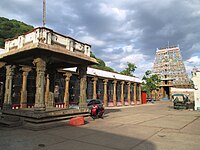
As per Hindu legend, Sage Suthapas was taking bath in Nupura Ganga at Alagar Hill and did not pay heed to sageDurvasa,who was passing by. The enraged Durvasa cursed Suthapas that he would turn into a frog until he is redeemed of his curse by Sundararajar, who is also known as Kallalagar. Suthapas, who is named as ‘MandukaMaharishi’ because of his frog form, performed penance on the banks of riverVaigai,which is otherwise known as Vegavathi, at Thenur. Kallalagar descended from his abode in Alagar Hill to redeem Manduka Maharishi off his curse. Since days unknown, it is believed that Kallalagar comes to Thenur via Malaipatti, Alanganallur and Vayalur. In Thenur Mandap, the lord redeems the sage of his curse and leaves for his abode. "During Thirumalai Nayak regime (1623 to 1659 CE), in 1653 the Manduka Maharishi relieving ritual was shifted to Vandiyur village where the event is performed at Thennur Mandapam, built by Thirumalai Nayak himself,".[4]
As per another Hindu legend, the presiding deity was worshiped byYama,the god of death. He requested Vishnu to stay in the place and built a temple with the help ofVishvakarma,the divine architect.[5]
Architecture[edit]
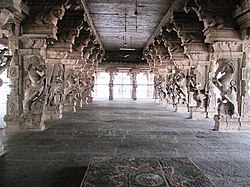
Kallalagar temple covers an area of about 2 acres (0.81 hectares) and has a seven-tieredgopuram(gateway tower). The temple in enclosed in a rectangular enclosure with huge granite walls. The central shrine houses the image of the presiding deity in standing posture. The images of Sridevi andBhudeviare also housed in the sanctum. There two life size images ofNarasimha,theavatarof Vishnu. One of them is shown holding the demon Hiranya and other slaying him.[6]There are separate shrines of Sundaravalli Nachiyar, Andal, Sudarshana and Yoga Narasimha around the shrines of the sanctum.[7]
The temple houses some rare Vijayanagara sculptures similar to the ones present inSoundararajaperumal Temple, Thadikombu,Krishnapuram Venkatachalapathy temple,Srivilliputhur Divya DesamandJalakandeswarar Temple, Vellore.[8]
The architecture of the Alagar temple corresponds to any of those of south Indian temples, with large gopurams and pillaredmandapams.The gopuram of the Karuppa swamy shrine depicts the passionate side of human relationship in the form of beautiful statues. Apart from these, it also depicts the evolution of cultural aspects of the local society including a depiction of an Englishman in British police uniforms.[4]
The main tower entrance (Mukya Gopuram) always remains closed, with the shrine ofKarupana Swami.The steps behind the closed door is worshipped asPatinettaam padi Karuppan(meaning, the black deity who occupies the eighteen steps). There are various legends associated with it. Once a year, the doors are opened andSudarshana Chakra(Chakrathalvar), the celestial discus, passes over through the open door. This is a centuries-old practice, where even the festive deity of the presiding deity is not allowed to pass through the doors.[4]
The famousVaishnavaworks in Tamil, belonging to the early 4th to 6th centuries point that to this temple as a Vishnu temple. TheSangam ageCilappatikarambelonging to 3rd century CE, points out to this temple as a Vishnu temple. During 2013, while cleaning the area in front of Karupana Samy shrine, a big Teppakulam was discovered, filled with sand and covered with dense undergrowth.[4]
Religious significance[edit]
Kallalagar temple is revered inNaalayira Divya Prabhandam,the 7th–9th century Vaishnava canon, byPeriyalvarandPeyalvar.The temple is classified as aDivyadesam,one of the 108 Vishnu temples that are mentioned in the book. During the 18th and 19th centuries, the temple finds mention in several works like108 Tirupathi Anthathiby Divya Kavi Pillai Perumal Aiyangar.[4]There are many waterbodies associated with the temple like Pandava, Hanuman, Uttara Narayana, Garuda. The ablution to the presiding deity is performed with waters from these tanks. The water from other sources, if used, is believed to turn the image to black colour.[citation needed]
Religious practises and festival[edit]
The temple follows the traditions of theTenkalaisect of Vaishnavite tradition and followsVaikanasa aagama.In modern times, the temple priests perform thepooja(rituals) during festivals and on a daily basis. As at other Vishnu temples of Tamil Nadu, the priests belong to theVaishnavaitecommunity, a Brahmin sub-caste. Six daily rituals are held at various times of the day and many yearly festivals are held at the temple, of which the float festival during theTamilmonth ofMasi(February–March),Navaratriduring September–October andVaikunta EkadasiduringMargali(December–January) being the most prominent. There are weekly, monthly and fortnightly rituals performed in the temple.[4]Abhishekam,ablution of the presiding deity, is performed only with the waters from Noopura Ganga, a lake on the top of the hill. Water from other sources is not used as it is believed to decolour the image.[7]
Every year during theTamil monthofChithirai(April-May),Chithirai Thiruvilais celebrated.Chithirai Thiruvilais an yearly event of the marriage ofMeenakshi,believed to be Alagar's sister.[9]The first 15 days of the event is celebrated inMaduraifor the arrangements between Meenakshi and Sundareswarar, while the next 15 days is about Alagar making preparations for her marriage. The main event is Kallalagar crossing the Vaigai river. Ethir Sevai is a part of the Chithirai Thiruvizha of the Kallazhagar temple at Alagar Koyil and begins on the fourth day. On this day, Alagar or Lord Vishnu changes his appearance as Kallar and travels via Kallar Nadu and enters Madurai and the city’s residents welcome him.[10]Millions of people gather in Madurai to witness this event. While Kallalagar enters the river, he learns that his sister's marriage is already over, he returns to Karuparayar Mandapam and then he takes tenavatarsand finally returns to Alagar Kovil. This temple obtained a newcar,after 300 years, built with a team of 15 artisans usingvengaitree wood for the structure and Burma teakwood for sculptures. The trial run was held on 6 July 2015.[11]The temple is one of the major tourist attraction in the region.[12]
References[edit]
- ^"Thirumaliruncholai | Pandiyanadu Divyadesams Tour Packages | 4 Days Yatra".108divyadesam.Retrieved20 May2024.
- ^M. S., Ramesh (1993).108 Vaishnavite Divya Desams: Divya desams in Pandya Nadu.Tirumalai-Tirupati Devasthanam.
- ^Hindu Religious and Charitable Endowments Act, 1959
- ^abcdef"Kallazhagar temple".Dinamalar. 2014.Retrieved31 May2014.
- ^Dalal, Roshan (2010).Hinduism: An Alphabetical Guide.Penguin Books India. p. 18.ISBN9780143414216.
- ^Rao, A.V.Shankaranarayana (2012).Temples of Tamil Nadu.Vasan Publications. p. 229–31.ISBN978-81-8468-112-3.
- ^abV., Meena.Temples in South India.Kanniyakumari: Harikumar Arts. pp. 15–16.
- ^S., Gopalakrishnan (December 1996). "The Raṅga-maṇḍapa of the Tāṭikkompu Temple A Study of an Iconographic Programme of the Vijayanagara Tradition".East and West.46(3/4): 415–431.JSTOR29757285.
- ^Anantharaman, Ambjuam (2006).Temples of South India(second ed.). East West. p. 127.ISBN978-81-88661-42-8.
- ^"Chithirai festival".hindustantimes.4 May 2020.Retrieved6 July2023.
- ^"Alagarkoil gets new car after 300 years".The Hindu.7 July 2015.Retrieved6 December2015.
- ^Karkar, S.C. (2009).The Top Ten Temple Towns of India.Kolkota: Mark Age Publication. p. 21.ISBN978-81-87952-12-1.


